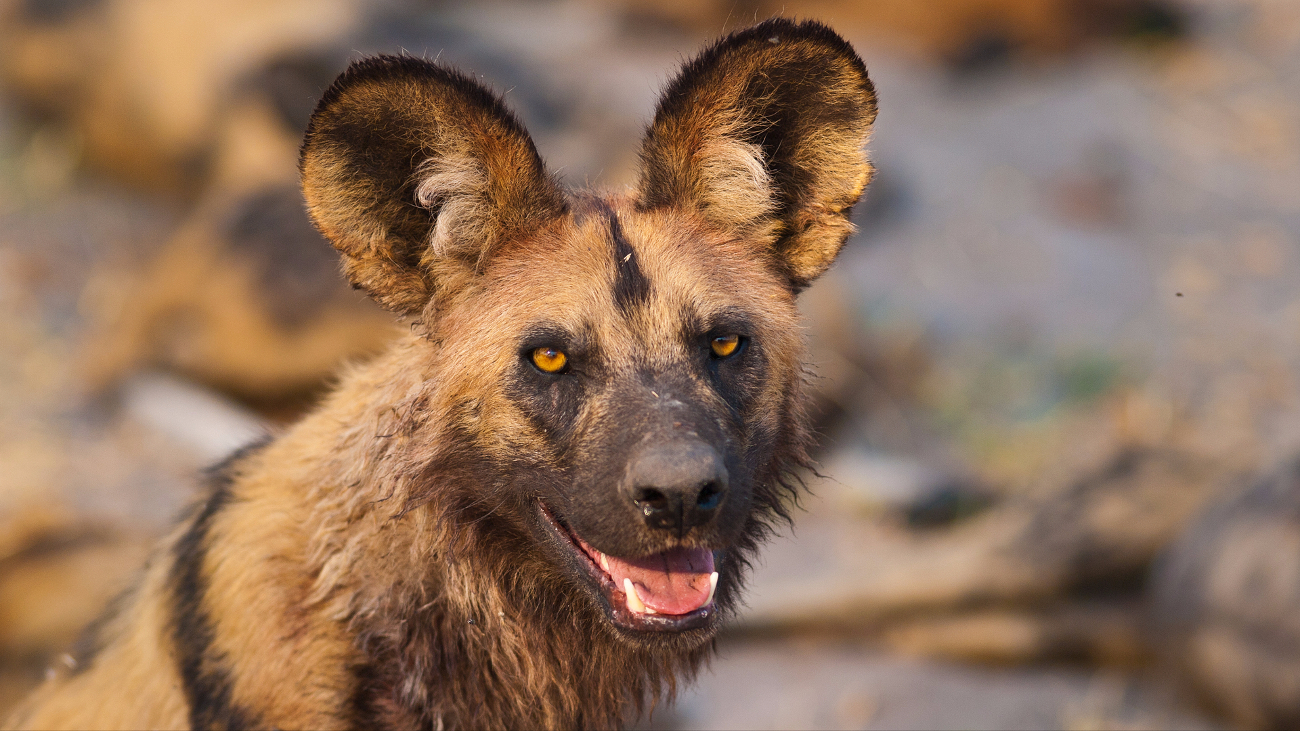- Home
- Conservancy
- African wild dog
Description
The African wild dog, African hunting dog, or African painted dog (Lycaon pictus) is a canid native to Sub-Saharan Africa. It is the largest of its family in Africa, and the only extant member of the genus Lycaon, which is distinguished from Canis by its fewer toes and dentition, which is highly specialised for a hypercarnivorous diet. It is classed as endangered by the IUCN, as it has disappeared from much of its original range. The current population has been estimated at roughly 39 subpopulations containing 6,600 adults, only 1,400 of which are fully grown. The decline of these populations is ongoing, due to habitat fragmentation, human persecution, and disease outbreaks.
The African wild dog is a highly social animal, living in packs with separate dominance hierarchies for males and females. Uniquely among social carnivores, it is the females rather than the males that scatter from the natal pack once sexually mature, and the young are allowed to feed first on carcasses. The species is a specialised diurnal hunter of antelopes, which it catches by chasing them to exhaustion. Like other canids, it regurgitates food for its young, but this action is also extended to adults, to the point of being the bedrock of African wild dog social life. It has few natural predators, though lions are a major source of mortality, and spotted hyenas are frequent kleptoparasites.
Fun Facts
The African wild dog has very strong social bonds, stronger than those of sympatric lions and spotted hyenas, thus solitary living and hunting is extremely rare in the species. It lives in permanent packs consisting of 2–27 adults and yearling pups. The average pack size in Kruger National Park and the Masai Mara is 4–5 adults, while packs in Moremi and Selous contain an average of 8–9. However, larger packs have been observed, and temporary aggregations of hundreds of individuals may have gathered in response to the seasonal migration of vast springbok herds in Southern Africa.
Males and females have separate dominance hierarchies, with the latter usually being led by the oldest female. Males may be led by the oldest male, but these can be supplanted by younger specimens, thus some packs may contain elderly former male pack leaders. The dominant pair typically monopolises breeding. The species differs from most other social species by the fact that males remain in the natal pack, while females disperse (a pattern also found in primates like gorillas, chimpanzees and red colobuses). Furthermore, males in any given pack tend to outnumber females
Dispersing females will join other packs and evict some of the resident females related to the other pack members, thus preventing inbreeding and allowing the evicted specimens to find new packs of their own and breed. Males rarely disperse, and when they do, they are invariably rejected by other packs already containing males. Although arguably the most social canid, the species lacks the elaborate facial expressions and body language found in the grey wolf, likely because of the African wild dog's less hierarchical social structure. Furthermore, while elaborate facial expressions are important for wolves in re-establishing bonds after long periods of separation from their family groups, they are not as necessary to African wild dogs, which remain together for much longer periods.
African wild dog populations in East Africa appear to have no fixed breeding season, whereas those in Southern Africa usually breed during the April–July period. During estrus, the female is closely accompanied by a single male, who keeps other members of the same sex at bay. The copulatory tie characteristic of mating in most canids has been reported to be absent or very brief (less than one minute in L. pictus, possibly an adaptation to the prevalence of larger predators in its environment. The gestation period lasts 69–73 days, with the interval between each pregnancy being 12–14 months on average.
The African wild dog produces more pups than any other canid, with litters containing around 6–16 pups, with an average of 10, thus indicating that a single female can produce enough young to form a new pack every year. Because the amount of food necessary to feed more than two litters would be impossible to acquire by the average pack, breeding is strictly limited to the dominant female, which may kill the pups of subordinates. After giving birth, the mother stays close to the pups in the den, while the rest of the pack hunts. She typically drives away pack members approaching the pups until the latter are old enough to eat solid food at 3–4 weeks of age.
The pups leave the den at around the age of three weeks, and are suckled outside. The pups are weaned at the age of five weeks, at which point they are fed regurgitated meat by the other pack members. By seven weeks, the pups begin to take on an adult appearance, with noticeable lengthening in the legs, muzzle and ears. Once the pups reach the age of 8–10 weeks, the pack abandons the den, and the young follow the adults during hunts. The youngest pack members are permitted to eat first on kills, a privilege which ends once they become yearlings.
